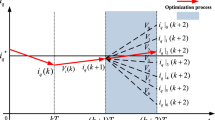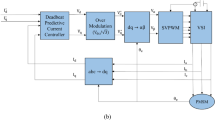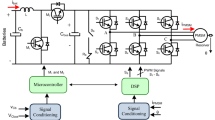Abstract
In order to effectively achieve torque demand in electric vehicles (EVs), this paper presents a torque control strategy based on model predictive control (MPC) for permanent magnet synchronous motor (PMSM) driven by a two-level three-phase inverter. A centralized control strategy is established in the MPC framework to track the torque demand and reduce energy loss, by directly optimizing the switch states of inverter. To fast determine the optimal control sequence in predictive process, a searching tree is built to look for optimal inputs by dynamic programming (DP) algorithm on the basis of the principle of optimality. Then we design a pruning method to check the candidate inputs that can enter the next predictive loop in order to decrease the computational burden of evaluation of input sequences. Finally, the simulation results on different conditions indicate that the proposed strategy can achieve a tradeoff between control performance and computational efficiency.
Similar content being viewed by others
References
B. Gasbaoui, A. Nasri. A novel 4WD electric vehicle control strategy based on direct torque control space vector modulation technique. Nonlinear Engineering, 2012, 3: 236–242.
P. Liu, H. P. Liu. Permanent-magnet synchronous motor drive system for electric vehicles using bidirectional Z-source inverter. IET Electrical Systems in Transportation, 2012, 4(2): 178–185.
C. H. T. Lee, K. T. Chau, C. H. Liu. Design and analysis of an electronic-geared magnetless machine for electric vehicles. IEEE Transactions on Industrial Electronics, 2016, 63(11): 6705–6714.
K. C. Kim. A novel calculation method on the current information of vector inverter for interior permanent magnet synchronous motor for electric vehicle. IEEE Transactions on Magnetics, 2014, 50(2): 829–832.
D. Casadei, F. Profumo, G. Serra. FOC and DTC: two viable schemes for induction motors torque control. IEEE Transactions on Power Electronics, 2002, 17(5): 779–787.
J. Rodriguez, P. Cortés. Predictive Control of Power Converters and Electrical Drives. Chichester: John Wiley & Sons,2012.
T. Geyer, G. Papafortiou, M. Morari. Model predictive direct torque contro–Part I: Concept, algorithm, and analysis. IEEE Transactions on Industrial Electronics, 2009, 56(6): 1894–1905.
C. Bordons, C. Montero. Basic principles of MPC for power converters. IEEE Industrial Electronics Magazine, 2015, 9(3): 31–43.
P. K. Manakos, T. Geyer, N. Oikonomou, et al. Direct model predictive control: A review of strategies that achieve long prediction intervals for power electronics. IEEE industrial Electronics Magazine, 2014, 8(1): 32–43.
P. Cortés, M. P. Kazmierkowski, R. M. Kennel, et al. Predictive control in power electronics and drives. IEEE Transactions on Industrial Electronics, 2008, 55(12): 4312–4324.
F. Morel, X. F. Lin-Shi, J. M. Rétif, et al. A comparative study of predictive current control schemes for a permanent-magnet synchronous machine drive. IEEE Transactions on Industrial Electronics, 2009, 56(7): 2715–2728.
M. Preindl, S. Bolognani. Model predictive direct torque control with finite control set for pmsm drive systems, part 1: Maximum torque per ampere operation. IEEE Transactions on Industrial Informatics, 2013, 9(4): 1912–1921.
J. J. Hong, D. H. Pan, Z. J. Zong. Comparison of the two current predictive-control methods for a segment-winding permanentmagnetlinear synchronous motor. IEEE Transactions on Plasma Science, 2013, 41(5): 1167–1173.
F. Barrero, J. Prieto, E. Levi, et al. An enhanced predictive current control method for asymmetrical six-phase motor drives. IEEE Transactions on Industrial Electronics, 2011, 58(8): 3242–3252.
S. Kouro, P. Coréts, R. Vargas, et al. Model predictive controla simple and powerful method to control power converters. IEEE Transactions on Industrial Electronics, 2009, 56(6): 1826–1838.
G. Prior, M. Krstic. A control Lyapunovapproach to finite control set model predictive control for permanent magnet synchronous motors. ASME Journal of Dynamic Systems, Measurement, and Control, 2015, 137(1): 1–10.
M. J. Duran, J. Prieto, F. Barrero, et al. Predictive current control of dual three-phase drives using restrained search techques. IEEE Transactions on Industrial Electronics, 2011, 58(8): 3253–3263.
T. Geyer. Computationally efficient model predictive direct torque control. IEEE Transactions on Power Electronics, 2011, 26(10): 2804–2816.
D. P. Bertsekas. Dynamic Programming and Optimal Control. 3rd ed. Nashua: Athena Scientific,2005.
D. Graovac, M. Pürschel. IGBT Power Losses Calculation Using the Data-Sheet Parameters. 129th ed. Neubiberg: Infineon Technologies AG,2009.
H. Chen, F. Allgöwer. A quasi-infinite horizon nonlinear model predictive control scheme with guaranteed stability. Automatica, 1998, 34(10): 1205–1217.
H. Chen. Model Predictive Control. 1st ed. System and Control Series. Beijing: Science Press,2013.
J. F. Stumper, A. Döltinger, R. Kennel. Classical model predictive control of a permanent magnet synchronous motor. EPE Journal, 2012, 22(3): 24–31.
E. L. Lawler, D. E. Wood. Branch-and-bound methods: A survey. Operations Research, 1996, 14(4): 699–719.
Author information
Authors and Affiliations
Corresponding author
Additional information
This work was supported by the NSFC Projects of International Cooperation and Exchanges (No. 61520106008), the National Natural Science Foundation of China (Nos. 61503149, U1564207) and the Graduate Innovation Fund of Jilin University (No. 2016093).
Bingtao REN received the B.Sc. degree in Automation from Jilin University, Changchun, China, in 2012, where he is currently working toward the Ph.D. degree in Control Theory and Control Engineering. His current research interests include torque coordination optimization and motor control of electric vehicles.
Hong CHEN received the B.Sc. and M.Sc. degrees in Process Control from Zhejiang University, Zhejiang, China, in 1983 and 1986, respectively, and the Ph.D. degree in System Dynamics and Control Engineering from the University of Stuttgart, Stuttgart, Germany, in 1997. Since 1999, she has been a Professor in Jilin University, Changchun, China, where she currently serves as Tang Aoqing Professor and as the Director of the State Key Laboratory of Automotive Simulation and Control. Her current research interests include model predictive control, optimal and robust control, nonlinear control and applications in mechatronic systems focusing on automotive systems.
Haiyan ZHAO received the B.Sc. degree in Automation, the M.Sc. and Ph.D. degree in Control Theory and Control Engineering from Jilin University, Changchun, China, in 1998, 2004 and 2007, respectively. Since 2007, she has been a lecturer in Jilin University, Changchun, China. Her current research interests include vehicle stability control and state estimation of electric vehicles.
Wei XU received the B.Sc. degree in Automation from Harbin University of Science and Technology, Harbin, China, in 2010, and received the M.Sc. degree in Pattern Recognition and Intelligent System from Jilin University, Changchun, China, in 2015, where she is currently working toward the Ph.D. degree in Control Theory and Control Engineering. Her current research focuses on regenerative braking system of electric vehicles.
Rights and permissions
About this article
Cite this article
Ren, B., Chen, H., Zhao, H. et al. MPC-based torque control of permanent magnet synchronous motor for electric vehicles via switching optimization. Control Theory Technol. 15, 138–149 (2017). https://doi.org/10.1007/s11768-017-6193-z
Received:
Revised:
Accepted:
Published:
Issue Date:
DOI: https://doi.org/10.1007/s11768-017-6193-z




